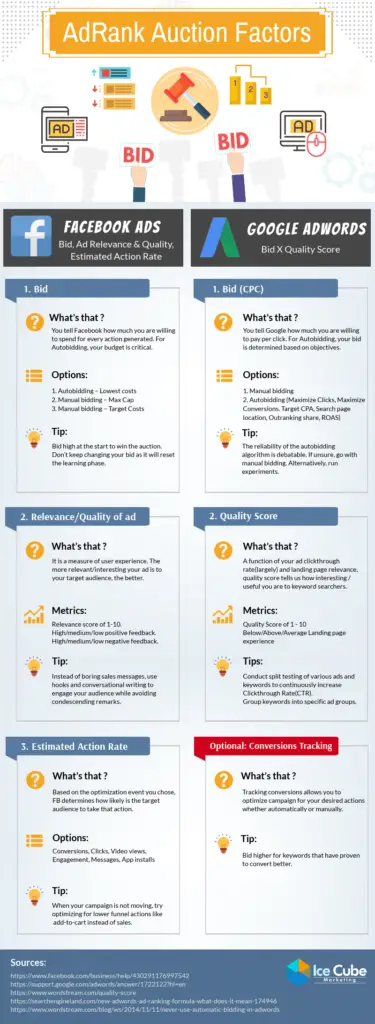The most popular advertising platforms for digital marketers is Facebook Ads and Google Adwords. Both of the platforms use some kind of auction system to place your ads.
Before you start campaigns on either or both platforms, there are several similarities and differences that you need to know about these two ads auction.
Ads Auction Infographic: A Comparison of Google and Facebook Ads Auction Platform
The infographic below is a comparison of Google and Facebook ads auction ranking factors from Ice Cube Marketing.

1. Bidding
Let’s start with the bidding. Both platforms use some kind of bidding system you have to use to place your ads.
For Facebook, the bidding is based on various actions you determine. This can be conversions, clicks, impressions, post engagement, and more. For Google Adwords, it’s on a cost per click basis.
Both platforms give you several options on how you want to bid. You can bid manually for the max you’d like to pay for your ad. There’s also auto bidding on both platforms.
Facebook allows you to auto bid for the lowest costs while Google Adwords lets you auto bid to meet several objectives. This includes maximizing clicks, targeting a CPA cost, targeting an ad position, focusing on conversions, etc.
Facebook auto bidding works better than Adwords if you’re on a tight budget. Auto-bidding for Adwords is usually not recommended because costs can easily go out of control.
2. Relevance and Ad Quality
Both platforms look at the relevance of your ad to determine its quality. This has an impact on how much you end up paying for your ad.
Facebook looks at how your ad matches your target audience to determine their relevance score.
Google Adwords uses something called a quality score. Quality score is determined by the CTR of your ad, relevancy of your landing page, and the optimization of your landing page. As a result, it’s easier to test ads for various types of keywords.
For Facebook, you want to focus on hooks and conversational writing to get the attention of your target audience. This will lead to them interacting with the ad (liking, sharing, commenting) and lead to the actions you need.
For Google Adwords, you have to really run many split tests for both your ad, ad group, keyword, and landing pages to see the best possible results.
3. Figuring Out Your Profitability
It’s important to get a good sense of how your ad will perform and optimize it further to see better results.
Facebook uses what’s called an Estimated Action Rate. This is a figure that they use to determine the likelihood of the target audience taking your desired action (clicks, likes, video plays, etc.)
It’s best to go for easier actions (like adding to cart) if you’re not seeing results rather than the sales conversion.
Google Adwords is all about tracking conversions. You can set a conversion goal for your campaign. Then you can optimize for this goal on either a manual or automatic basis.
Usually, the idea here is to find the sweet spot for your ad in terms of ad cost, position, and targeting. If you start to see results for specific keywords, you can try to bid higher for a better position as that may increase traffic and conversions.
Ted is from Ice Cube Marketing, a digital marketing agency in Singapore that helps local small businesses acquire leads from channels such as Facebook and Google.


